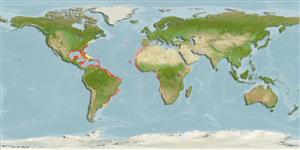Common names from other countries
Environment: milieu / climate zone / depth range / distribution range
Écologie
marin; saumâtre; profondeur 0 - 100 m (Ref. 26999). Subtropical; 43°N - 37°S, 98°W - 14°E
Western Atlantic: Massachusetts (USA), northern Gulf of Mexico, and throughout the Caribbean Sea to Brazil. Eastern Atlantic: Senegal to Angola, including the Canary Islands and Cape Verde.
Length at first maturity / Taille / Poids / Âge
Maturity: Lm ?, range 35 - ? cm
Max length : 200 cm TL mâle / non sexé; (Ref. 27000); common length : 70.0 cm TL mâle / non sexé; (Ref. 5217); poids max. publié: 1.8 kg (Ref. 57401)
Épines dorsales (Total) : 6; Rayons mous dorsaux (Total) : 9; Épines anales: 2; Rayons mous anaux: 8. Diagnosis: 102-119 scales in lateral line; no chevrons on the flanks or, if present, not so well marked as in Sphyraena afra (Ref. 57401).
Occurs in shallow and generally turbid coastal water over muddy bottoms, often around river estuaries. Schooling species (Ref. 6949). Occasionally enters estuaries and brackish waters (Ref. 57401). Feeds on mainly on fishes belonging to the Engraulidae, Clupeidae, Lutjanidae and Synodontidae families and also on squid from the Loliginidae family (Ref. 9626). Maximum reported size: 71cm (Ref. 57401). Marketed fresh and salted.
Life cycle and mating behavior
Maturities | Reproduction | Spawnings | Egg(s) | Fecundities | Larves
De Sylva, D.P., 1990. Sphyraenidae. p. 860-864. In J.C. Quero, J.C. Hureau, C. Karrer, A. Post and L. Saldanha (eds.) Check-list of the fishes of the eastern tropical Atlantic (CLOFETA). JNICT, Lisbon; SEI, Paris; and UNESCO, Paris. Vol. 2. (Ref. 6949)
Statut dans la liste rouge de l'IUCN (Ref. 130435)
CITES (Ref. 128078)
Not Evaluated
Menace pour l'homme
Harmless
Utilisations par l'homme
Pêcheries: commercial
Outils
Articles particuliers
Télécharger en XML
Sources Internet
Estimates based on models
Preferred temperature (Ref.
115969): 19.4 - 27.9, mean 25.1 (based on 752 cells).
Phylogenetic diversity index (Ref.
82804): PD
50 = 0.5000 [Uniqueness, from 0.5 = low to 2.0 = high].
Bayesian length-weight: a=0.00794 (0.00507 - 0.01244), b=2.96 (2.83 - 3.09), in cm Total Length, based on LWR estimates for this species & Genus-body shape (Ref.
93245).
Niveau trophique (Ref.
69278): 4.4 ±0.3 se; based on diet studies.
Résilience (Ref.
120179): Très faible, temps minimum de doublement de population supérieur à 14 ans (Preliminary K or Fecundity.).
Fishing Vulnerability (Ref.
59153): Very high vulnerability (90 of 100).
